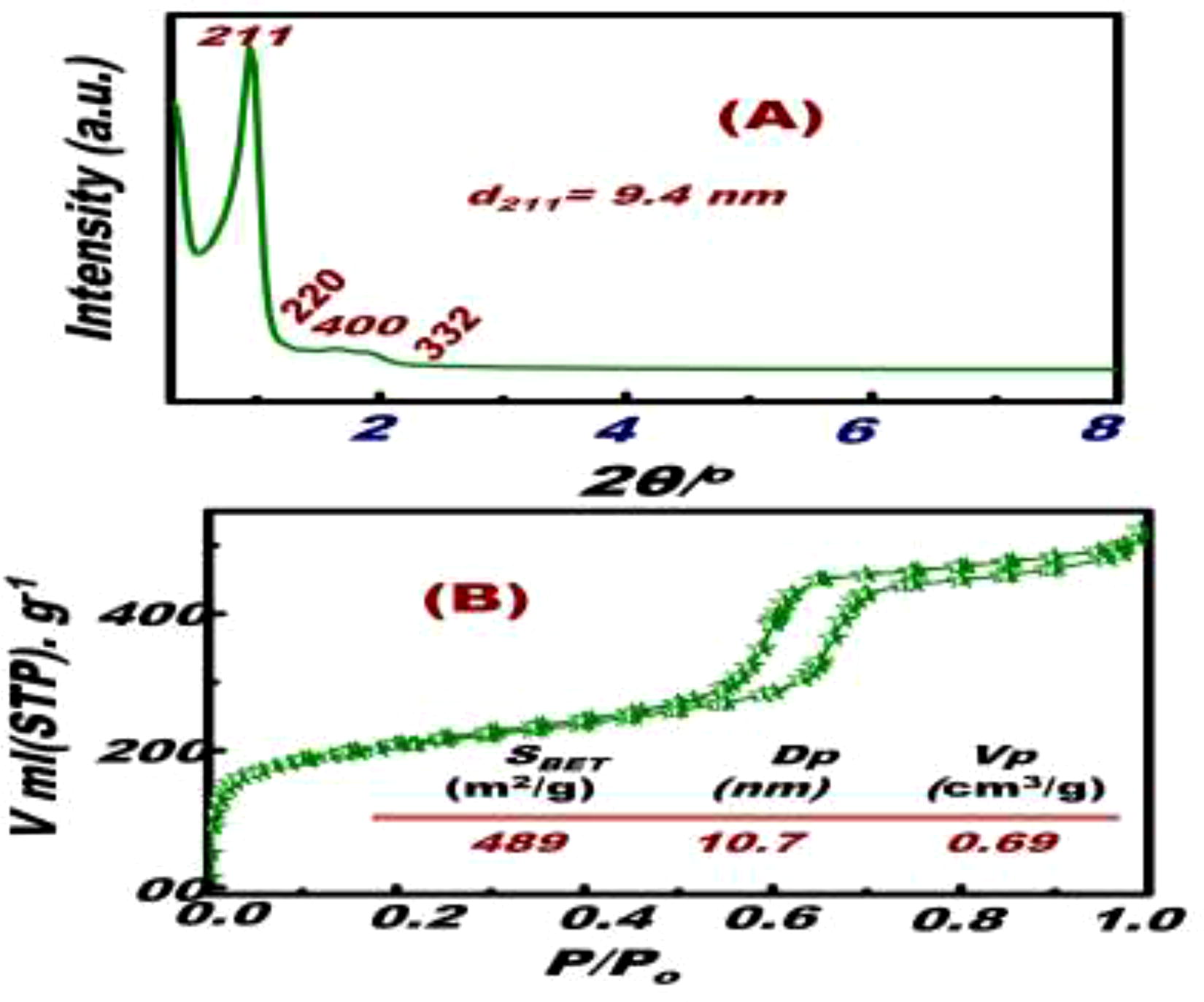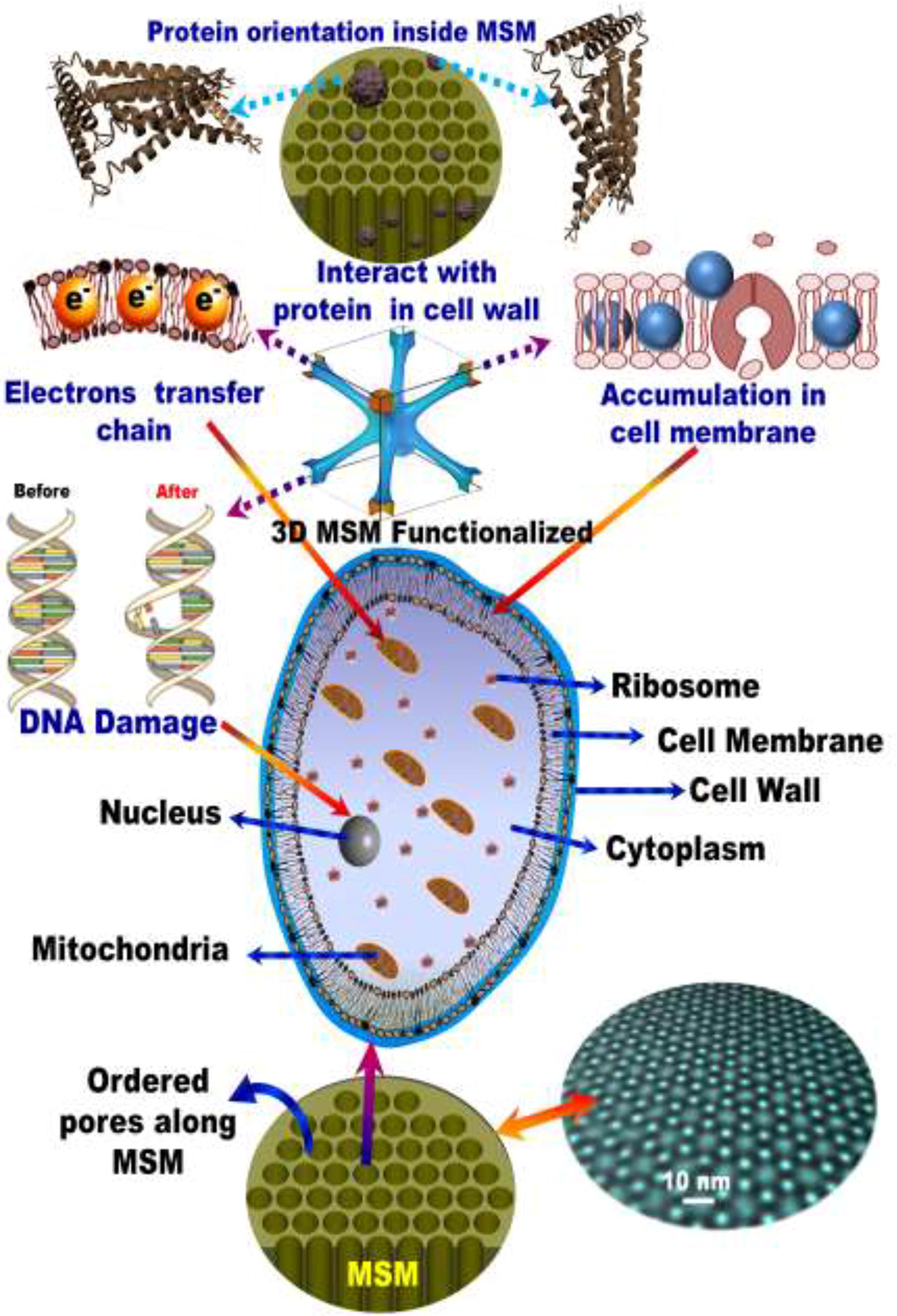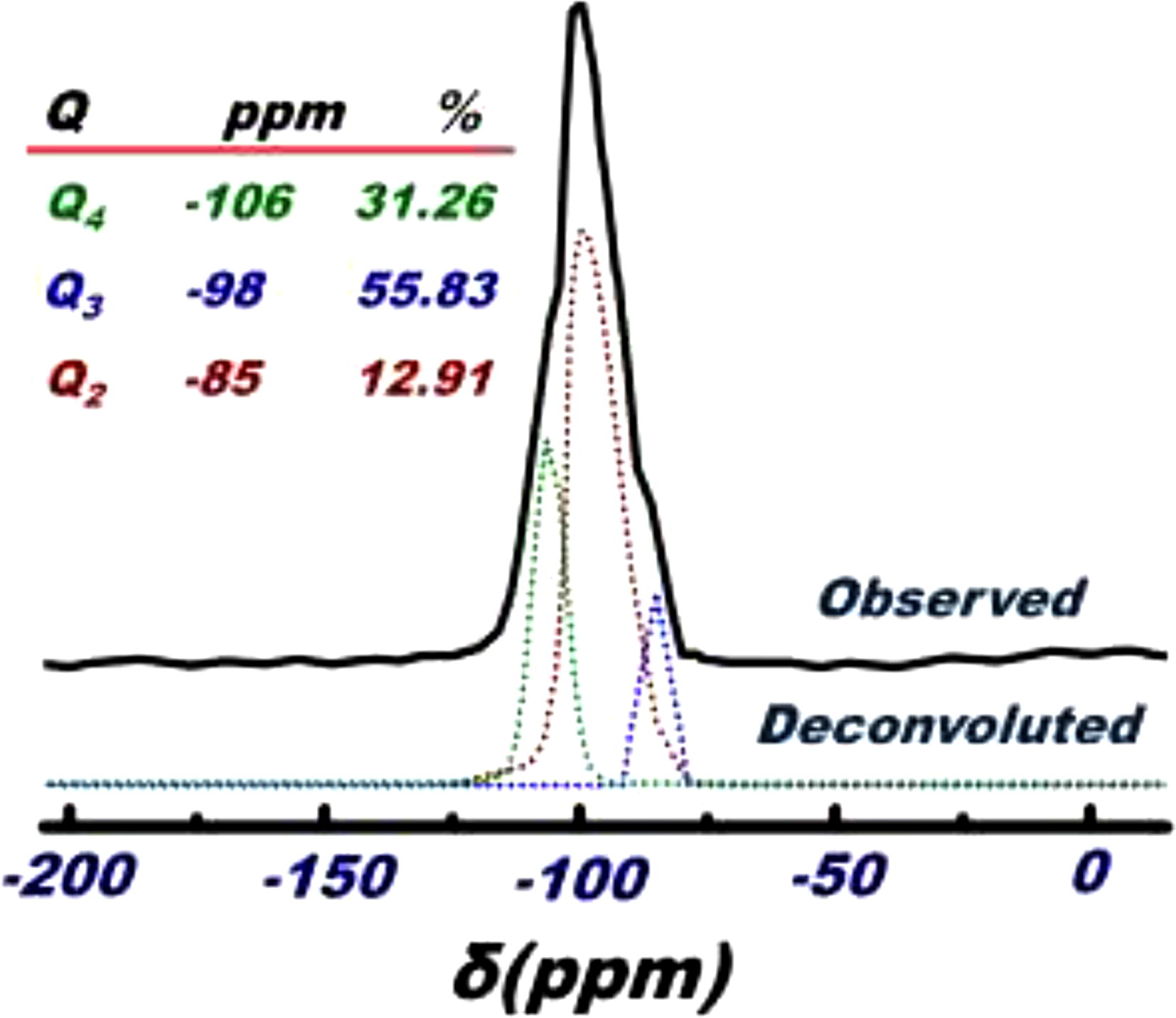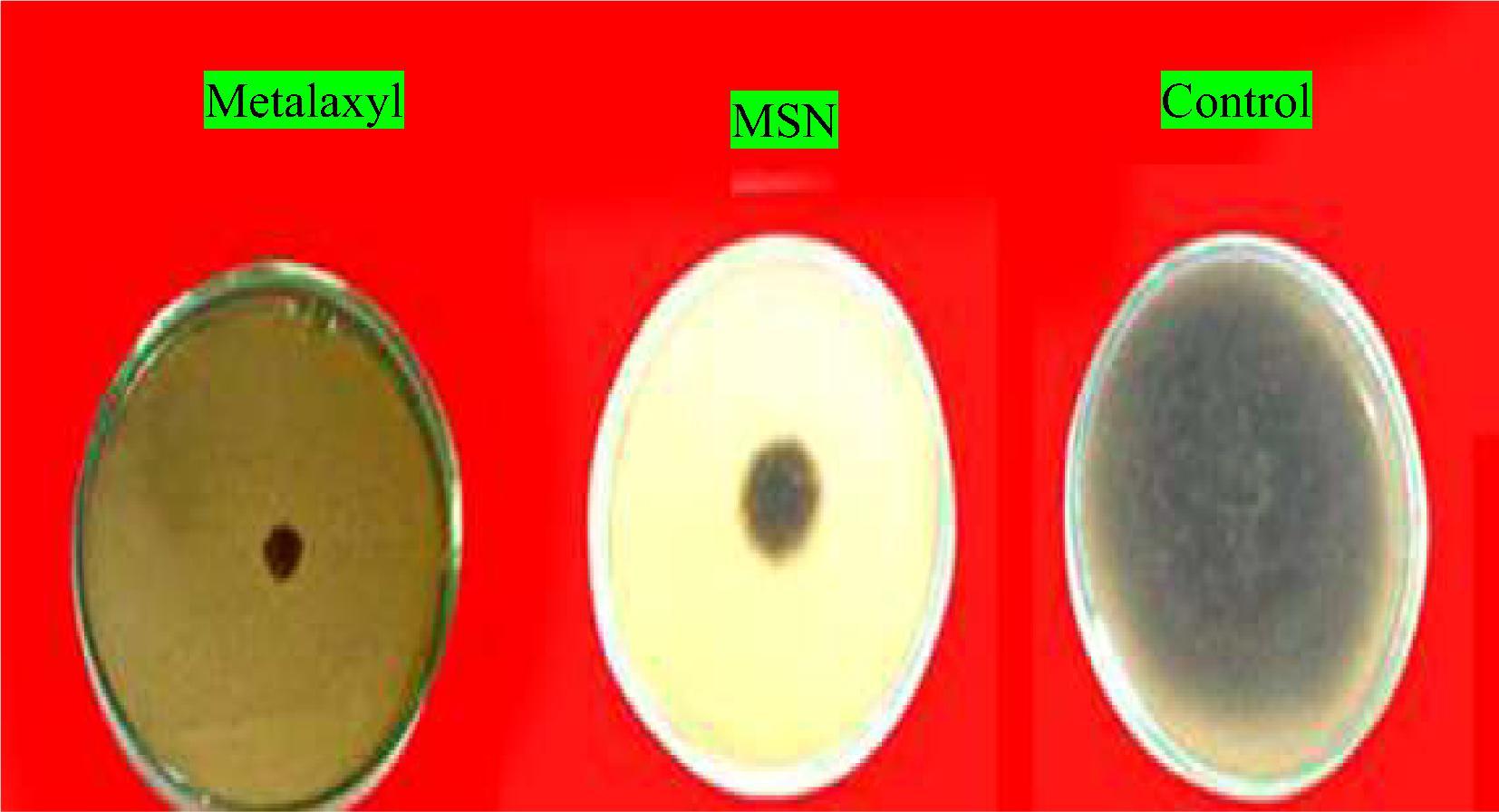 ?Mathematical formulae have been encoded as MathML and are displayed in this HTML version using MathJax in order to improve their display. Uncheck the box to turn MathJax off. This feature requires Javascript. Click on a formula to zoom.
?Mathematical formulae have been encoded as MathML and are displayed in this HTML version using MathJax in order to improve their display. Uncheck the box to turn MathJax off. This feature requires Javascript. Click on a formula to zoom.Abstract
There is a growing interest in the development of alternative strategies in plant disease management to reduce dependency on synthetic chemicals. In this study, we described synthesis and evaluation of the direct antifungal activity of mesoporous silica nanoparticles (MSN) compared to metalaxyl (recommended fungicide) against A. solani under laboratory and greenhouse conditions. The structural features of MSN such as high porosity, small particle size and suitable shape contributed to its high antifungal efficacy against Alternaria solani. Laboratory synthesized MSN showed marked increase in tomato growth parameters compared to untreated control. Our study presents promising results of the use of MSN as an effective and safe alternative of fungicides for managing tomato early blight.
Keywords:
Introduction
Tomato (Lycopersicon esculentum L. H. Karst.) is an important vegetable crop worldwide. Tomato early blight caused by Alternaria solani is one of the most destructive diseases worldwide; yield losses of up to 80% have been attributed to this disease [Citation1Citation[2]–Citation3] .
The control of tomato early blight mainly relies on the frequent use of synthetic fungicides. Numerous fungicides are potential compounds against this pathogen but these chemicals are not ideal long-term solutions because of the high cost, residues, and the impacts on the environment and human health [Citation4Citation[5]Citation[6]–Citation7] . Moreover, the evolution of resistance of plant pathogens such as A. solani against fungicides is a problem of major concern [Citation8,Citation9] . Therefore, safe, effective, and eco-friendly control agents are in demand [Citation10]. Recently, the search for new control agents in pest management has become an urgent task. Nanotechnology can play significant role in this regard. The development of novel agents for detection and control of plant diseases are examples of the major contributions of nanotechnology to agriculture and food systems [Citation11]. Nanotechnology can play several roles in the progress of available plant protection tools [Citation12] and may be used in the control of plant pathogens in terms of control agents delivery or disease detection.
Mesoporous materials such as silica have widespread applications, i.e., in disease diagnosis and therapy [Citation13Citation[14]Citation[15]Citation[16]–Citation17] . Recently, the attention given to mesoporous silica is attributed to their unique characteristics, such as uniformed mesoporous tunnels, narrow pore size distribution, good biocompatibility, low toxicity, and chemical stability. Much effort has been devoted toward the improvement and manipulation of this material for various applications. In addition, the design of mesoporous and nanomaterials with engineered features, including geometrical shapes, framework matrices, compositions, and active-site functions, have important advantages in applications for medical and agricultural purposes.
In this study we described the synthesis and evaluation of mesoporous silica nanoparticles (MSN) with large, tunable, and open cylindrical pores as potential antifungal agent against A. solani under laboratory and greenhouse conditions. The efficacy of MSN was evaluated against tomato early blight as compared with the recommended fungicide, metalaxyl.
Materials and methods
Source of chemicals
Tetramethylorthosilicate (TMOS), dodecane (C12H26), and the triblock copolymers of poly(ethyleneoxide–b-propylene oxide–b-ethylene oxide) (Pluronic P123; EO20PO70EO20) were obtained from the Sigma-Aldrich Company, Ltd. (USA). These analytical-grade chemicals were used without further purification. Metalaxyl is the recommended fungicide for the control of tomato early blight pathogen; this chemical with a trade name of Metalaxyl 25% EC Nanjing Essence Fine-Chemical Co., Ltd. was obtained from the Agricultural Development Co., Ltd. (Cairo, Egypt).
Synthesis of MSN
The one-pot direct template approach was used to synthesize the MSN, as previously reported [Citation18Citation[19]–Citation20] .
Characterization of MSN
A Belsorp Min-II analyzer was used to test the N2 adsorption–desorption isotherms at 77 K. Based on the Brunauer–Emmett–Teller (BET) theory, the specific surface area (SBET) was determined with multi-point adsorption data from the linear portion of the N2 adsorption isotherms. The cylindrical pore diameter was defined by Barrett–Joyner–Halenda (BJH) analyses. The small/wide angle powder X-ray diffraction (XRD) measurements of the fabricated material were conducted with a 18 kW diffractometer (Bruker D8 Advance) with monochromated Cu Kα irradiation. Transmission electron microscopy (TEM) micrographs were obtained with a 200 kV electron microscope (JEOL 2000 EX II). Field-emission scanning electron microscopy (FE-SEM) images were obtained with a Hitachi S-4300 microscope. Carbon tape was used as a substrate to fix the MSN powder on a SEM stage before insertion into the chamber. The 29Si MAS NMR spectra were obtained with a Bruker AMX-500 spectrometer.
Assessment of growth inhibition
The efficacy of MSN and metalaxyl were evaluated against A. solani under laboratory conditions. The efficacy was determined as the per cent of inhibition in the growth relative to the control treatment. Potato dextrose agar (PDA) medium was poured into Petri dishes with 15 ml per dish. One well was punched in the center of each plate after solidification. The plates were inoculated in the center with a disk (5 mm diameter) bearing the mycelium growth from the A. solani culture (5 days old culture). A 50 µl aliquot of MSN and metalaxyl, at concentrations of 100, 200, 300 and 400 mg/l, was added to the respective punched holes. A 50 µl aliquot of sterilized liquid medium was added into selected wells as the control. The plates were sealed with parafilm to reduce the evaporation of the tested materials. The incubation time for the plates at 28 °C was extended until the full growth of A. solani (mycelia reached the edge of the plate) in the untreated control. The formula by Vincent [Citation21] was used to calculate the percentage of inhibition of A. solani as shown in Eq. Equation(1)(1)
(1) . Each treatment was replicated three times and per replication five plates were maintained.
(1)
(1) where A is the fungal radial growth in the control, and B is the fungal radial growth in the treatment.
Preparation of spore suspension
Pathogenic A. solani isolated from infected tomato plant and identified in Plant Pathology Research Institute, Giza Egypt, was grown on potato dextrose agar for culturing. To enhance sporulation, cultures were exposed to fluorescent light (80 µmol/m2/s) for 6 h daily prior to use. For each Petri dish, 10 ml of sterilized water was added and the conidia were collected using a sterilized brush. The spore suspension of the fungus was filtered through three layers of nylon mesh. The concentration of conidia was determined and adjusted to 106 conidia/mL with a hemocytometer.
Experimental design and treatments
The efficacy of MSN was studied in pots under greenhouse conditions at the Kafr El-Sheikh University Farm in Egypt for two growing seasons (2013/2014–2014/2015). Completely randomized design was used for this experiment with four replicates for accurate data. For each pot, 5 one-month-old tomato seedlings (GS13 variety) were transplanted (20 cm high; 25 cm diameter) filled with sterilized soil. After two weeks of transplanting, tomato seedlings (45 days old) were inoculated with A. solani as foliar spray with a spore suspension of 106 conidia/ml [Citation22]. The inoculated plants were covered with plastic bags for 48 h to maintain the high relative humidity and support fungal infection [Citation23]. After one week of incubation, the respective growing seedlings were sprayed with MSN and metalaxyl at concentration levels of 200 and 400 mg/l using hand atomizer. Tomato seedlings were sprayed twice with 10 days intervals. Control treatment was sprayed with water only. Disease severity was determined after 10 days of last spray. The scale by [Citation24] was used to calculate disease severity. Plant height, fresh and dry weight were measured after 10 days of the last spray to evaluate the effect of applied treatments on tomato growth parameters.
Statistical analysis
Statistical analysis for the data was performed with JMP soft-ware version 8 using the Turkey Kramer HSD test for determining significant differences among treatment at P = 0.05 level.
Results
Characterization of the fabricated MSN antifungal agent
The SA-XRD pattern of MSN antifungal agent is shown in A. This pattern reflects the well-ordered structure of the fabricated MSN, with the well-resolved diffraction peaks and characteristic SA-XRD patterns of the Ia3d symmetry with a highly ordered mesostructure. The SA-XRD pattern showed the well-defined (2 1 1), (2 2 0), (4 0 0), and (3 3 2) diffraction planes that are features of highly ordered cubic Ia3d nanophase domains (A).
Fig. 1 SA-XRD (A) and N2 isothermal (B) patterns of MSN antifungal agents. Inserts A, the assignment of the diffraction peaks of cubic Ia3d mesostructures. Inserts B, The structural surface parameters of Surface area (SBET), pore size (Dp) and pore volume (Vp), respectively of cubic Ia3d mesostructures.

The pore size distribution of cubic Ia3d silica MSN was examined by N2 adsorption isotherms (). The isotherm exhibited typical type-IV sorption with the typical H1 hysteresis loop of characteristic cylindrical mesoporous materials [Citation19,Citation25] . The analysis of the adsorption isotherms with the BET method revealed that the SBET of silica was 489 m2/g, the VP was 0.69 cm3/g, and the DP was 10.7 nm.
Fig. 2 HR-TEM (A) and FE-SEM (B-D) micrographs of MSN antifungal agents. Inserts A, the electron diffraction of selected area recorded along the {3 1 1} zone axis f cubic Ia3d mesostructures. (C-D) the morphological surface of cubic Ia3d mesostructures clearly showed the formation of large micrometric voids (1–4 µm), leading for high absorptivity and diffusivity of bulk fungicide species.

Key features of this material design include the high level of 3D arrangement, nano-sized particle morphology, and uniform mesoporous distribution of the target into the mesoporous surface architectures, as proven by analyzing the TEM and SEM micrographs, XRD patterns, and N2 isotherm profiles (–). The TEM images of cubic Ia3d silica monoliths were recorded along the [3 1 1] direction (A) and showed the well-defined and regulated mesopore channels that were harmonized along all directional configurations. The insert in A is the corresponding ED pattern analysis, which reveals that the formation of ordered cubic Ia3d lattice symmetry of the silica monolith is congruous with the well-defined XRD patterns. FE-SEM micrographs of the silica monoliths demonstrated the stable morphologies of the molecules for all cases of calcined and crushed monoliths, In addition, large-sized particles with diameters of 20–150 μm were present (B–D). Remarkably, the monoliths in micrometer-sized particles were a result of the aggregation of large amounts of nanoparticles. The developed MSN featured such as 3D cubic Ia3d structures, with cylindrically-shaped and uniform pore sizes, as well as the conversion of monodispersed meso-/macro-porosities into ultra- or micrometer-sized particles (≥150 μm). These features probably increased its efficiency as a potential antifungal agent against early blight disease of tomato. showed the three resolved signals of the monolithic cubic Ia3d silica sample at the chemical shift (δ) of −85, −98, and −106 ppm. These features can be readily assigned by spectra to provide the deconvolution of the silicon atoms of silanol groups on the surface, which were described as the (Q2), (Q3), and (Q4) species, respectively [Citation26,Citation27] .
Growth inhibition of A. solani under laboratory conditions
A. solani growth was significantly inhibited by MSN and metalaxyl at various concentrations compared with the untreated control. However, the highest growth inhibition percentage of A. solani was achieved at the highest concentration (400 mg/L) ( and ). The degree of growth inhibition positively correlated with MSN and metalaxyl concentration level.
Table 1 In vitro efficacy of different concentrations of MSN and metalaxyl against A. solani.
Efficacy under greenhouse conditions
MSN and metalaxyl significantly reduced the severity of early blight of tomato as compared with untreated control in two growing seasons (). The degree of severity reduction positively correlated with concentration levels of the tested materials. The severity reduction was higher in the second season than in the first one.
Table 2 Effect of the MSN and metalaxyl treatments on the severity of A. solani in tomato in two tested seasons.
Effects on growth parameters
The effect of MSN on the growth characters of tomato plants was assessed by comparing with metalaxyl (). The measured growth parameters were plant height, fresh weight, and dry weight. The tomato growth characters were significantly increased in treated plants compared to the untreated control. Fresh and dry weight of tomato plants treated with MSN increased two fold more than untreated control in both growing seasons.
Table 3 Effect of the MSN and metalaxyl on some growth parameters of treated tomato plants in the last season.
Discussion
Early blight is a fungal disease that caused by Alternaria solani that occurs on tomatoes worldwide. This fungal disease is generally one of the most severe tomato problems faced and if uncontrolled, early blight can cause significant yield reduction [Citation28]. Therefore, for top yield of high quality tomato fruit, control of this pathogen is essential. The frequent use of fungicides for control of early blight disease resulted in environmental pollution and hazardous effects on human [Citation4,Citation5,Citation7] . This is beside that the application of fungicides led to the emergence of resistant strains of fungi to fungicides [Citation8,Citation9] . Therefore new safe and effective alternatives of fungicides to control plant pathogens such as early blight of tomato considered a source of major concern. The concept of utilizing silica nanoparticles as an antimicrobial agent is comparatively new [Citation29], as the focus has now been shifted towards making non-toxic, safe nanoparticles [Citation30]. The potential effect MSN against early blight disease agrees with many studies reported that several nanoparticles such as silver and selenium controlled this disease effectively [Citation31,Citation32] . The physical characteristics and structural features of MSN, such as the high surface area, unique structure, cylindrically-shaped and uniform pore sizes led to its high antifungal efficacy against A. solani.
The mode of action of any control agents are very important and help in improving the efficacy of it when we faced some defects of its efficacy. The mechanism of MSN action against A. solani is not clearly known till now but there are many theories in this regard. The fungicidal activity of MSN as proposed in may be attributed to the deactivation of protein molecules or the direct contact with pathogen DNA and cause mutations in DNA and affect replication [Citation33–Citation34] . In addition, the antifungal effect of MSN may be achieved via the facile breakdown of the cell wall due to its small size by forming hydrogen bonds between lipopolysaccharides of the cell wall and surface hydroxyl groups present in MSN [Citation35]. Then the accumulation of MSN in the membrane may induce cell lysis [Citation36] by preventing the trans-membrane energy cycle or form insoluble compounds in the fungal membrane that disrupt the electron transport chain or oxidation of the cell membrane due to the positive charge of MSN and the negative charge of cell membrane which produces the electromagnetic attraction between bot and cell immediately dies [Citation37]. The surface characteristics of MSN support this point of view since the positively charged MSN interacts with the protein thiol groups (-SH) on the fungal cell surface to cause cell lysis [Citation38]. Finally, MSN may function against A. salani by increasing tomato plant resistance, physiological characteristics and its self-defense against the disease by absorbing silicon (Si) into plants. [Citation39Citation[40]Citation[41]–Citation42] .
Fig. 5 Schematic representation of various mechanisms (cell membrane interaction, DNA damage, protein interaction in cell wall, interruption electron transfer chain) of antifungal activity of MSN.

The unique features of MSN such as high surface area (SBET) of 489 m2/g and small pore size (Dp) of 10.7 expected to improve the significance of its surface morphology participating in the cellular interaction i.e., the number of active sites coming in contact with the cells which render cytotoxic effect against early blight fungus. Also, it is well known that the smaller particles have larger surface area available for interaction and will give more antimicrobial effect than the larger particles.
Any management strategy for plant pathogens should not focus only on the effective control of the pathogens that attack the agricultural crops. It should also take in consideration its effect on growth and yield characters of crops. Significant increase in growth parameters of tomato plants treated with MSN were recorded and this is agreed with findings of [Citation43], who reported that the application of control agents suppresses diseases incidence and can have positive effects on plant growth and yield. This increase may be attributed to the fact that MSN and metalaxyl could reduce the influence of early blight fungus on the green area in tomato leaves; thus, decreased the damaged green leaf area which finally led to increase the plant growth because the leaves can undergo more photosynthesis [Citation44].
Also, one of the most important factors is the amount of MSN that could be used under field conditions and its suitability/applicability is not known. The amount needed from MSN to spray one acre depend on our results if we supposed that one acre (4046.85 m2) need 100 L water may be 40 g. We think, this amount is applicable and comparable to the tested fungicide amount (30 g/4046.85 m2) and cost effective.
The safety is considered one of the key factors for any agents used control agricultural pests. These control agents should not affect the environment and the public health. Recently in two studies with different designs of silica nanoparticles have been found effective in killing bacterial cells without damaging human cells [Citation45,Citation46] . This confirms the safety of MSN to human health and its use can reduce the hazards effects caused by chemical fungicides.
The physical mode of action of MSN against A. solani make it not specific to this fungus only which strongly supports the use of MSN against other plant pathogens because the fungus is unlikely to become genetically or physiologically resistant to such physical mechanism. In addition, the multiple sites of action limit the possibility that fungi will become resistant to MSN.
Conclusions
MSN effectively reduced the severity of early blight disease in tomato and improved tomato growth characters also. It is expected that the application of MSN nanoparticles at low concentrations will be eco-friendly and decrease farm management costs. The easy synthesis of MSN is a highly promising approach to designing and synthesizing other metal oxides with powerful antifungal activity; that can be used as a safe alternative to chemical fungicides to control tomato early blight.
References
- R.S.SinghDiseases of vegetable crops1985Oxford and IBH Publishing Co.New Delhi, Bombay, Calcutta346
- K.MathurK.S.ShekhawatChemical control of early blight in kharif sown tomatoIndian J Mycol Plant Pathol161986235236
- S.S.ChandravanshiB.P.SinghM.P.ThakurPersistence of different fungicides used against Alternaria alternata in tomatoIndian Phytopathol471994241244
- R.S.KookanaS.BaskaranR.NaiduPesticide fate and behaviour in Australian soils in relation to contamination and management of soil and water: a reviewAust J Soil Res361998715764
- A.WightwickG.AllinsonPesticide residues in Victorian waterways: a reviewAust J Ecotoxicol13200791112
- K.G.YousufA.K.HaroonD.NugegodaG.RoseClimate change environmental and biological aspects2010New India Publishing AgencyDelhi India
- M.KomarekE.CadkovaV.ChrastnyF.BordasJ.C.BollingerContamination of vineyard soils with fungicides: a review of environmental and toxicological aspectsEnviron Inter362010138151
- J.S.PascheL.M.PicheN.C.GudmestadEffect of the F129L mutation in Alternaria solani on fungicides affecting mitochondrial respirationPlant Dis892005269278
- F.Abu-El SamenS.G.GoussousA.Al-ShudifatI.MakhadmehReduced sensitivity of tomato early blight pathogen (Alternaria solani) isolates to protectant fungicides, and implication on disease controlArch of Phytopathol Plant Protect492016120136
- L.K.MdeeP.MasokoJ.N.EloffThe activity of extracts of seven common invasive plant species on fungal phytopathogensSouth Afri J Bot752009375379
- J.WeissP.TakhistovD.J.McClementsFunctional materials in food nanotechnologyJ Food Sci712006107116
- R.NairS.H.VargheseB.G.NairT.MaekawaY.YoshidaD.S.KumarNanoparticulate material delivery to plantsPlant Sci1792010154163
- S.R.ThangamV.SujithaK.VimalaS.KannanLigand-conjugated mesoporous silica nanorattles based on enzyme targeted prodrug delivery system for effective lung cancer therapyToxicol Appl Pharmacol272014232243
- Z.YuanZ.XinZ.JingwenP.GuoqingQ.WangwangW.Xiaohuet al.Synergistic mediation of tumor signaling pathways in hepatocellular carcinoma therapy via dual-drug-loaded pH-responsive electrospun fibrous scaffoldsJ Mater Chem B17201534363446
- J.YaoN.SunC.DengX.ZhangDesigned synthesis of Graphene @titania @mesoporous silica hybrid material as size-exclusive metal oxide affinity chromatography platform for selective enrichment of endogenous phosphopeptidesTalanta1502016296301
- X.XieF.LiH.ZhangY.LuS.LianH.Linet al.EpCAM aptamer-functionalized mesoporous silica nanoparticles for efficient colon cancer cell-targeted drug deliveryEurop J Pharma Sci8320162835
- F.RehmanA.Abdur RahimP.L.O.Claudio Airoldi VolpePreparation and characterization of glycidyl methacrylate organo bridges grafted mesoporous silica SBA-15 as ibuprofen and mesalamine carrier for controlled releaseMater Sci Eng592016970979
- S.A.El-SaftyT.HanaokaFabrication of crystalline, highly ordered three-dimensional silica monoliths (HOM-n) with large, mmorphological mesopore sstructureAdv Mater15200318931899
- S.A.El-SaftyT.HanaokaF.MizukamiTransparent cubic Fd3m mesoporous silica monoliths with highly controllable pore architecturesJ Mater Chem1520052590
- S.A.El-SaftyY.KiyozumiT.HanaokaF.MizukamiCationic surfactant templates for newly developed cubic Fd3m silica mesocage structureMater Lett6220082950
- J.H.VincentDistortion of fungal hyphae in presence of certain inhibitorNature151947850
- V.V.DatarC.D.MayeeChemical management of early blight of tomatoJ Maharashtra Agric Univ31985278280
- M.R.HilaalEpidemiological study on early blight of tomatoes in relation to fungicidal resistance (M.Sc. Thesis)1992Faculty of Agriculture Ain Shams University Egypt167
- B.J.ChirstEffect of disease assessment methods on ranking potato cultivars for resistance to early blightPlant Dis751991353
- S.A.El-SaftyM.A.ShenashenA.ShahatTailor-made micro-object optical sensor based on mesoporous pellets for visual monitoring and removal of toxic metal ions from aqueous mediaSmall913201322882296
- S.A.El-SaftyA.ShahatM.IsmaelMesoporous aluminosilica monoliths for the adsorptive removal of small organic pollutantsJ Hazard Mater20120122332
- M.A.ShenashenE.A.ElshehyS.A.El-SaftyM.KhairyVisual monitoring and removal of divalent copper, cadmium, and mercury ions from water by using mesoporous cubic Ia3d aluminosilica sensorsSep Purificat Technol11620137386
- N.M.HassaneinM.A.AbouzeidK.A.YoussefD.A.MahmoudControl of tomato early blight and wilt using aqueous extract of neem leavesPhytopathol Med492010143151
- A.BesinisT.De PeraltaR.D.HandyThe antibacterial effects of silver, titanium dioxide and silica dioxide nanoparticles compared to the dental disinfectant chlorhexidine on Streptococcus mutans using a suite of bioassaysNanotoxicol812014116
- C.S.TankS.RamanS.KaranN.P.GosaviV.LallaR.Satheet al.Antimicrobial activity of silica coated silicon nano-tubes (SCSNT) and silica coated silicon nano-particles (SCSNP) synthesized by gas phase condensationJ Mater Sci24201314831490
- A.A.IsmailN.M.SidkeyR.A.ArafaR.M.FathyA.I.El-BatalEvaluation of in vitro antifungal activity of silver and selenium nanoparticles against Alternaria solani caused early blight disease on PotatoBr Biotechnol J122016111
- A.I.El-BatalN.M.SidkeyA.A.IsmailR.M.ArafaFathy M.RashaImpact of silver and selenium nanoparticles synthesized by gamma irradiation and their physiological response on early blight disease of potatoJ Chem Pharmaceut Res842016934951
- A.PeticaS.GavriliuM.LunguN.BurunteaC.PanzaruColloidal silver solutions with antimicrobial propertiesMater Sci Eng1521–320082227
- H.F.SalemK.EidM.SharafFormulation and evaluation of silver nanoparticles as antibacterial and antifungal agents with a minimal cytotoxic effectInter J Drug Deliv32011293304
- L.B.CapelettiL.F.De OliveriaGoncalves K.DeAlmeidaJ.F.A.DeOliveiraA.SaitoJ.Kobarget al.Tailored silica–antibiotic nanoparticles: overcoming bacterial resistance with low cytotoxicityLangmuir30201474567464
- S.GillD.E.FoutsG.L.ArcherE.F.MongodinR.T.DeboyJ.Ravelet al.Insights on evolution of virulence and resistance from the complete genome analysis of an early methicillin-resistant Staphylococcus aureus strain and a biofilm-producing methicillin-resistant Staphylococcus epidermidis strainJ Bacteriol187200524262438
- S.Rezaei-ZarchiA.JavedM.J.GhaniS.SoufianF.B.FirouzabadiA.B.Moghaddamet al.Comparative study of antimicrobial activities of TiO2 and CdO nanoparticles against the pathogenic strain of Escherichia coliIran J Pathol5220108389
- H.ZhangG.ChenPotent antibacterial activities of Ag/TiO2 nanocomposite powders synthesized by a one-pot sol-gel methodEnviron Sci Technol438200929052910
- T.L.W.GarverB.J.ThomasM.P.RobbinsR.J.ZeyenPhenyalanine ammonia-lyase inhibition, auto fluorescence, and localized accumulation of silicon, calcium and manganese in oat epidermis attacked by the powdery mildew fungus Almeria graminis (DC) speerPhysiological Mol Plant Pathol521998223243
- J.F.MaS.GotoK.TamiM.IchiiRole of root hairs and lateral roots in silicon uptake by ricePlant Physiol127200117731780
- M.BrechtL.DatnoffR.NagataT.KucharekThe role of silicon in suppressing tray leaf spot development in St. Augustine grass2003Publication in University of Florida14
- T.KantoA.MiyoshiT.OgawaK.MaekawaM.AinoSuppressive effect of potassium silicate on powdery mildew of strawberry in hydroponicsJ Gen Plant Pathol702004207211
- N.S.El-MougyM.M.Abdel-KaderS.M.LashinA.A.MegahedFungicides alternatives as plant resistance inducers against foliar diseases incidence of some vegetables grown under plastic houses conditionsInter J Eng Innovat Technol3620137181
- N.D.PaveleyK.D.LockleyR.Sylvester-BradleyJ.ThomasDetermination of fungicide spray decisions for wheatPesticide Sci491997379388
- M.LiongB.FranceK.A.BradleyJ.I.ZinkAntimicrobial activity of silver nanocrystals encapsulated in mesoporous silica nanoparticlesAdv Mater21200916841689
- J.SongH.KimY.JangJ.JangEnhanced antibacterial activity of silver/polyrhodanine-composite-decoratedsilica nanoparticlesACS Appl Mater Inter520131156311568


